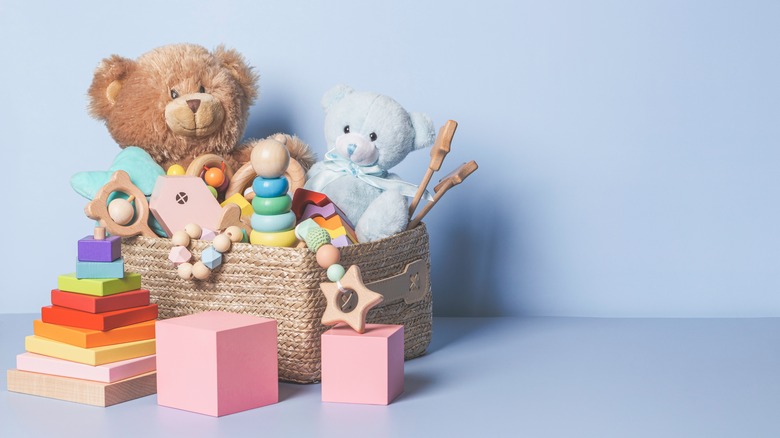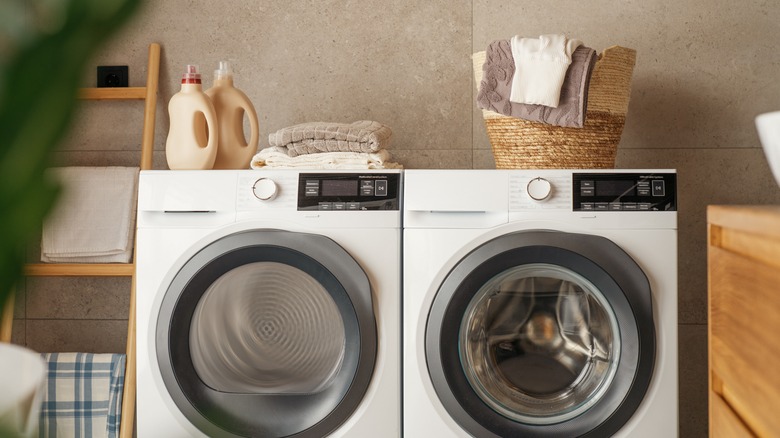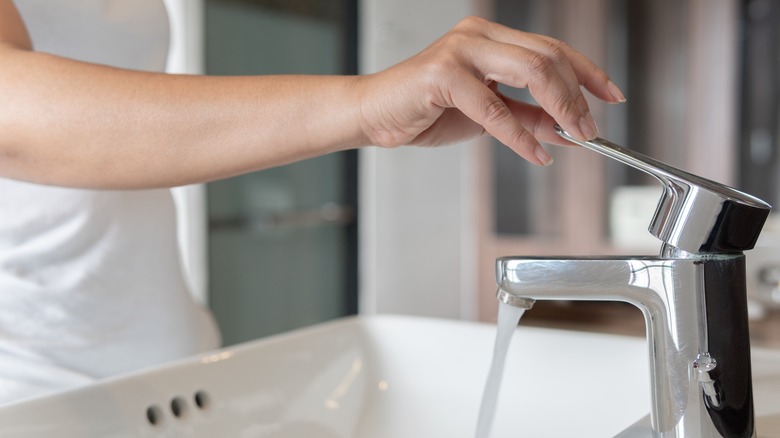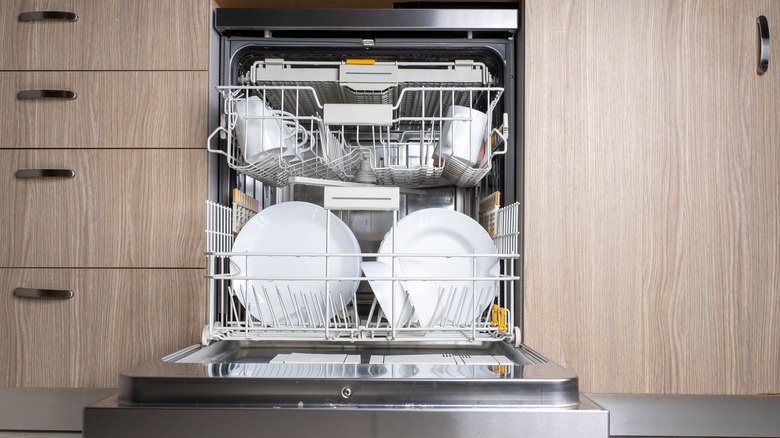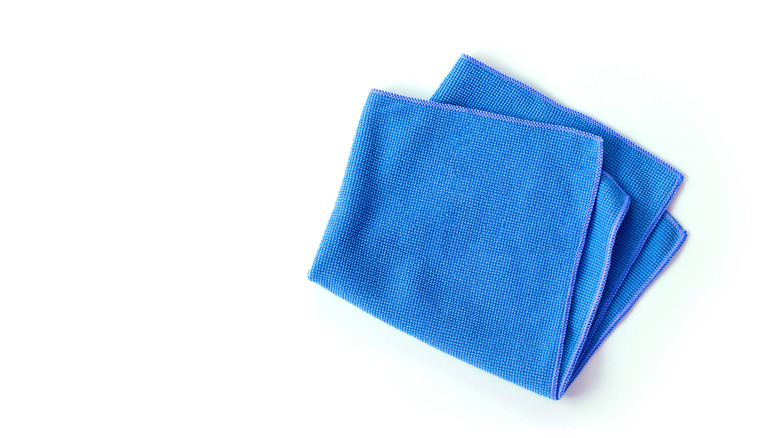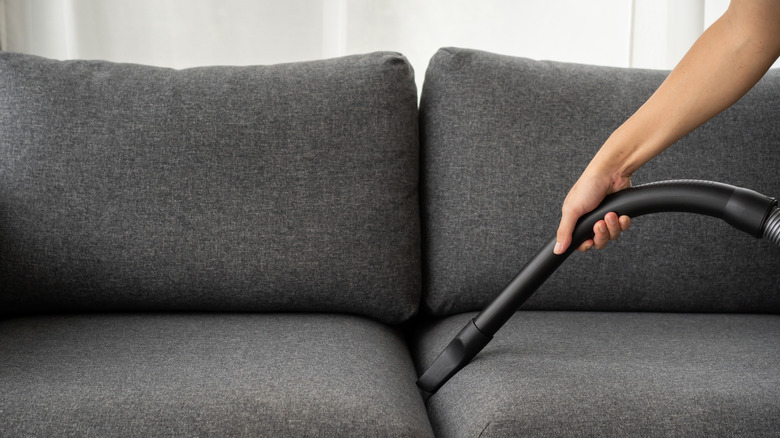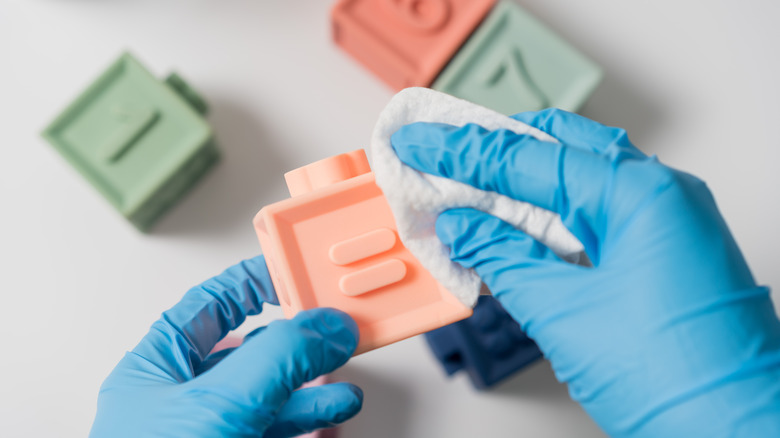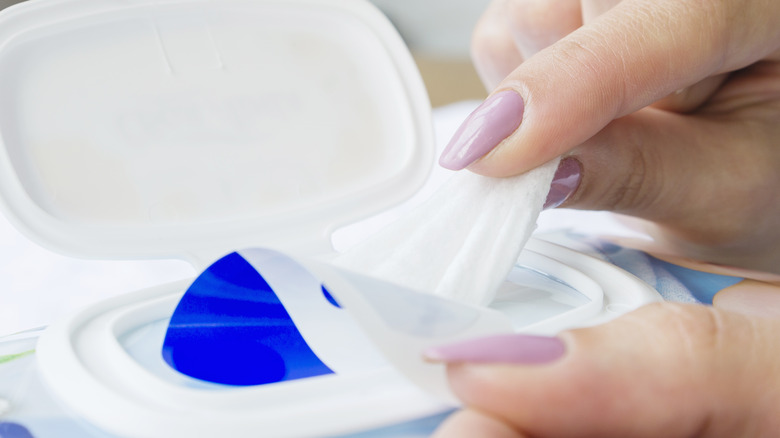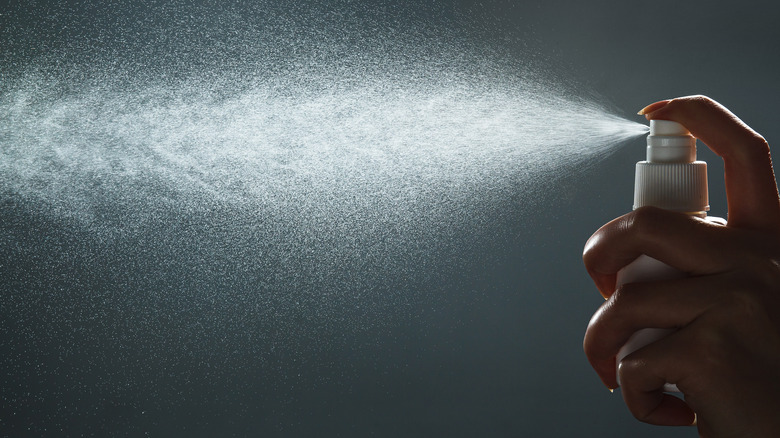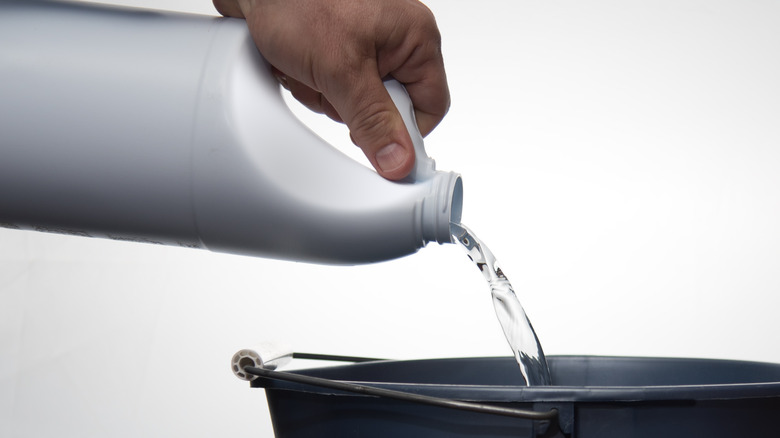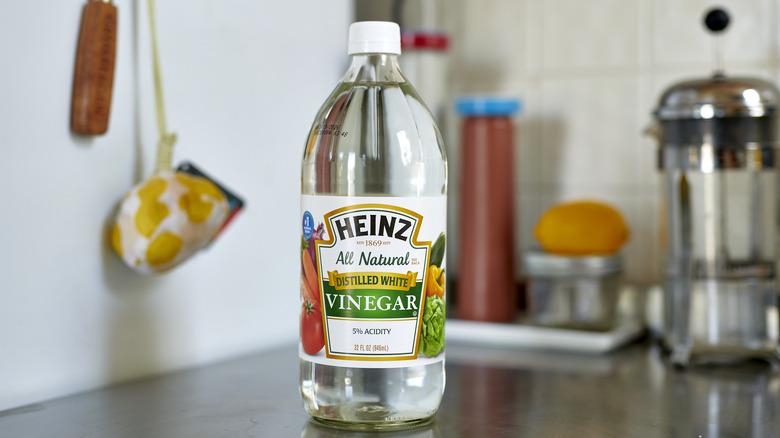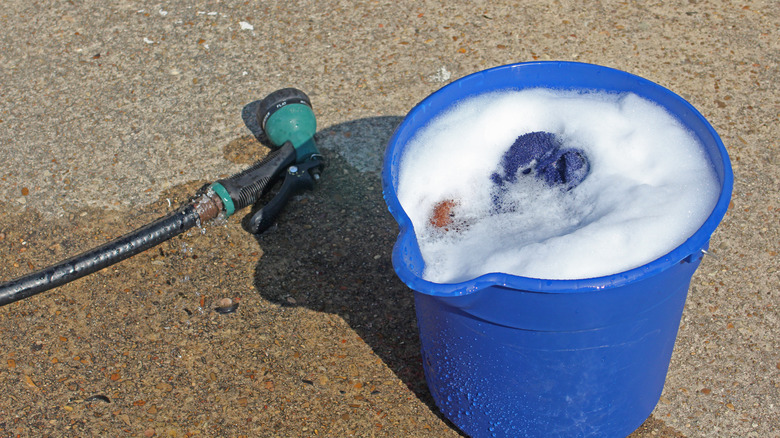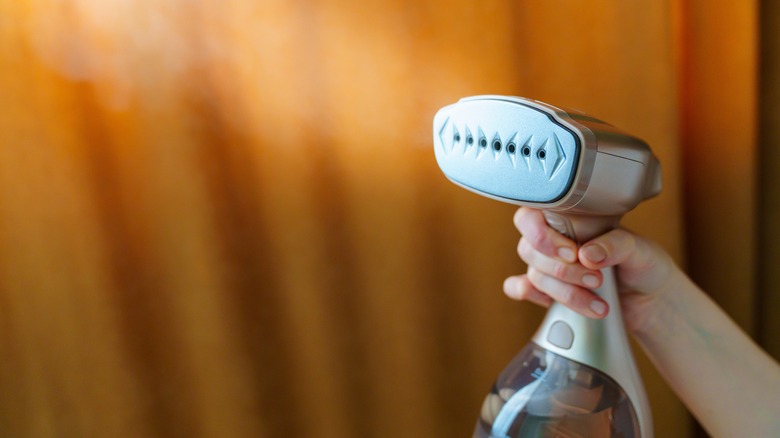How To Clean Your Kids' Stuffed Animals And Toys
We may receive a commission on purchases made from links.
Tossed on the floor, rolled in the dirt, drooled on overnight, and victim to spills and sticky fingers, there's just no way around it — toys get dirty. If your child's favorite teddy bear is looking worse for wear or taking on an odor, it's time for a good deep clean. Besides getting toys to look and smell more presentable, there's another good reason to give them an occasional wash. In a 2016 study published in the Pediatric Infectious Disease Journal, scientists found that viruses can survive on toys for hours, potentially infecting others. Cut down on these germs by giving toys the scrub down they need.
This means cleaning toys that babies and kids mouth daily, bath toys after each use, and all other toys when noticeably soiled or smelly. It's also prudent to clean toys after any illness exposure. To clean items thoroughly and avoid damage, different toy types will need different cleaning treatments.
Wondering exactly how to clean your kids' stuffed animals and toys? The first step is to check the manufacturer's guidelines for cleaning directions. If there are no directions, consider the toy's materials and size to choose a suitable cleaning process. We've rounded up the best cleaning methods to help rid toys of dirt, odors, and germs and get them as close to their former glory as possible.
Washing machine
For many soft toys, a run through the washing machine is all it takes to get them nice and clean. Of course, not all toys can be machine-washed. Hard toys will make too much of a racket, delicate toys are better off with a hand wash, and toys that can't be soaked should not go through the washer (like those with electronic parts). If the toy has a care label, follow its directions to choose the wash cycle type, wash temperature, and drying instructions.
If the toy does not have a care label, Whirlpool recommends a few steps to protect the toy from damage. A color fastness check helps ensure the toy will come out the same color it went in. Color test the toy by rubbing some diluted laundry detergent. If the color bleeds, don't use detergent to clean the toy.
A gentle wash setting is usually enough to clean the toy, though extra dirty, sturdy toys may need a regular cycle wash. Many toys will fare fine if thrown directly in the washer, but for extra protection, consider putting the toy in a mesh laundry bag or tied-up pillowcase. If the care label says the toy can go through the dryer, follow the label's directions. If not, air drying is safer than machine drying. Stuffed animals can be laid flat or hung to dry.
Hand wash
Hand washing is the tried-and-tested method to get cooties off of cherished playthings. Hand washing is suitable for any toy that can be soaked, such as many soft toys, as well as plastic, silicone, rubber, and some metal toys (as long as they're dried quickly to prevent rusting). It's also a good choice for delicate or worn toys that might not fare well in the washing machine.
The best hand washing method depends on the toy. For soft toys, check if there is a care label for the ideal washing temperature. If the toy directions don't specify cold water, wash with warm water. Not only does warm water feel more comfortable, but it also removes grime and stains more readily than cold water. For hard toys, a mild dish soap is a good choice, while fabric toys are best cleaned with a mild laundry detergent.
It's harder to get water out of hand washed soft items, so Whirlpool recommends rolling the toy in a dry towel to soak up moisture before drying the toy. If the care label says so, the toy can be dried in the dryer. Fragile toys should not be thrown in the dryer — air drying is best. The same goes for hard toys like plastic and silicone. Laying the toys out to air dry prevents damage.
Dishwasher
For many parents, the dishwasher is a saving grace for getting daily chores done. Turns out it can help with one more task around the house: cleaning toys. Some hard plastic or silicone toys can be run through the dishwasher to get them both clean and sanitized. Dishwasher-safe toys include teething toys, pacifiers, plastic blocks, rattles, and hard plastic models. Consult the toy instructions or reach out to the manufacturer to see if the toy is safe to wash in the dishwasher. If the manufacturer doesn't specify, keep in mind that the high temperatures of a dishwasher can melt some toys. Hard, sturdy plastics and silicones are the safest bet since they're less likely to melt. Avoid placing electronic toys or toys with loose parts in the dishwasher.
According to Lake Appliance Repair, there are a few things to remember when putting toys in the dishwasher. Place small toys (pretty much any toys that can fit through the racks) in the silverware basket to keep them contained. Just like more delicate dishes go on the top rack, more delicate toys should go in the same area. Large toys can go in the bottom rack. When it comes to washing, using the delicate wash cycle can lower the risk of damage. Also, for toys you're unsure are dishwasher-safe, switch off the heated dry function (or remove the toys before the drying cycle) to prevent any parts from warping or melting.
Spot clean
Sometimes, washing the entire toy is not suitable (or necessary). Spot cleaning is ideal for almost any toy since it just requires a light dab of water and soap. Spot cleaning is also the preferred way to clean delicate toys that might not handle a big wash, such as threadbare toys or plushies that fail the color fastness test.
All it takes to spot clean a toy is soapy water (made with either mild soap or laundry detergent) and something to clean the toy with. A soft cloth will work in most situations and has the benefit of being gentle on the toy. To ensure no dye transfers onto the toy, Minna Goods recommends using a white towel or cloth. For more sticky or set-in messes, like melted chocolate or stuck-on candy, use a more abrasive cloth or a dish sponge. After cleaning the spot with soapy water, follow up with a dab from a clean, wet cloth to remove any soap residue. Spot cleaning is also great for cleaning messes when you're outside of the home. A quick wipe with a baby wipe or wet tissue can remove larger residue and make it easier to clean the toy once you're back home.
Vacuum
For dusty toys, bring out the trusty vacuum to suck up dust. This cleaning method is suitable for vacuums that have a vacuum hose. It's also best for larger toys that won't get sucked up into the vacuum, although there is a workaround for vacuuming smaller toys. While using the vacuum hose alone is fine, using the vacuum hose attachments can make the job easier. For example, the upholstery attachment helps clean children's play furniture and other large, soft surfaces. The dust brush attachment can vacuum and fluff up a plush toy simultaneously. Use the crevice attachment to clean in the tight spots of toys, like the corners and crevices of a play kitchen.
To ensure the vacuum doesn't suck up anything it shouldn't, try the vacuum pantyhose hack explained by Squeaky Green House Clean. Take the pantyhose and put them over the vacuum hose. The fine mesh allows you to vacuum while ensuring no small pieces get sucked up and lost. This hack is useful when vacuuming larger toys to ensure no rogue, small toys (like LEGO pieces or beads) are vacuumed up. It's also a good hack for cleaning plushies with parts that can accidentally come loose, like eyes or buttons.
Wipe down
Almost all toys can benefit from a good wipe down to eliminate visible dirt and grime. A gentle wipe down is the safest option for some toys, like electronic toys, books, or fragile toys. Surface cleaning can remove dust and dirt, depending on your method. For dusting, brushing away loose grime, or getting rid of fingerprints, a swipe with a microfiber cloth may be enough to do the trick. A dry wipe down is the first method to try for items sensitive to water, like electronics, books, and porous wood toys. This method won't get rid of all the germs, but it also won't harm toys.
For tougher messes, it's time to bring in some water and soap. Use a soft cloth and water, or a diluted mix of water and soap next. Make sure to wring out the cloth well before using it to ensure it isn't too wet. This step is especially important when cleaning electronic toys to prevent water from getting into any cracks and crevices. When cleaning electronic toys, The Maids outlines a few important steps to remember: Don't spray any liquid directly on the electronics, and disconnect or remove the power source before cleaning. If the mess doesn't lift, don't use more water. Just pass over the sticky or dirty spot a few more times to get it clean.
Disinfecting wipes
There's a notable difference between cleaning and disinfecting, according to the CDC. Cleaning uses soap and water to lift and wash away germs, whereas disinfecting uses chemicals to kill germs. These two are most effective when done in tandem: Cleaning first to remove dirt and germs, then disinfecting second to kill any remaining germs. Disinfecting wipes can go beyond cleaning toys and actually cut down on the number of germs on the surface, which is especially useful after an illness exposure. They are best used on non-porous toys after visible dirt and grime have already been cleaned off.
Most disinfectant wipes are suitable for this job, as long as you follow the directions. Keep in mind that toys need to stay wet with the disinfecting solution for a certain amount of time to kill germs. Since kids put toys in their mouths, many parents may prefer to use natural disinfecting wipes, like the Seventh Generation Disinfecting Multi-Surface Wipe. Instead of bleach or ammonium compounds, these wipes use thymol to disinfect. Thymol is derived from thyme oil, making it a more natural alternative. Since this product is EPA-registered, it is proven to kill germs as promised. Regardless of the wipe type, unless otherwise directed, it's also prudent to rinse the toys after to make sure no residue is left behind.
Hydrogen peroxide
Hydrogen peroxide is another excellent option for disinfecting non-porous toys. According to the CDC, it's effective against several microorganisms, including viruses, bacteria, fungi, and spores. This makes hydrogen peroxide an excellent choice for disinfecting after sickness or exposure to outdoor elements. A 3% concentration of hydrogen peroxide, the option you'll see in most stores, is a high enough concentration to work as a disinfectant at home. There are a few factors to keep in mind when using it. Firstly, it should be stored in dark bottles since light exposure breaks it down (via How Stuff Works). Secondly, hydrogen peroxide can have a bleaching effect, which is why it's not a great cleaner for soft plush toys.
The best way to clean toys with it is by using a spray bottle. Similar to using other sanitizers, the toy should be clean of visible grime before disinfecting. Hydrogen peroxide can be used at its total 3% concentration from the bottle, or for a weaker but still effective solution, Cleveland Clinic recommends a 50/50 mix of hydrogen peroxide and water. Five minutes of contact time should be enough for a good clean. While hydrogen peroxide is safe, a rinse after disinfecting offers extra peace of mind.
Sanitize with bleach
Bleach is a safe, effective, and affordable choice for home disinfection, including disinfecting toys. Since bleach can, well, bleach, it can damage fabric toys and is only suitable for non-porous toys, like plastic toys. Bleach is an effective disinfectant that is useful if a toy gets particularly mucky, like if it is exposed to bodily fluids. Similar to the other disinfectants on this list, bleach should be used to sanitize after the toy has already been cleaned. The same safety rules always apply when using bleach: Don't mix it with other cleaners, and make sure to dilute it to a suitable ratio. For childcare settings (and for use at home for children's toys), the DuPage County Health Department recommends mixing a ¼ teaspoon of unscented bleach with 1 quart of water. Make the bleach solution fresh for each use since bleach breaks down once mixed with water.
There are several ways to use this bleach solution to clean toys. The first option is to use a spray bottle to saturate toys or play surfaces — just make sure not to spray clothes or furniture accidentally. To clean a bunch of toys, immerse the batch in a bucket of diluted solution. Let the toys air dry for the bleach to do its work effectively. Since chlorine evaporates in the drying process, no leftover residue should exist. However, some parents may still choose to rinse the toys after.
Vinegar solution
Parents looking for a natural cleaning solution can reach for white vinegar. As the National Science Foundation notes, vinegar has some disinfecting properties, although it is not as effective as disinfecting products like bleach or wipes. However, vinegar has its place in a toy cleaning routine as an effective cleaner and odor remover. It's safe to use on any toys that are safe to clean with water.
There are several ways to use vinegar to clean toys. It can be used as-is from the bottle or diluted with water to your preferred ratio (the NSF recommends a 1:1 ratio of vinegar and water for home cleaning). One method is to make a bucket of vinegar solution and use a soft cloth to wipe items down. Wonder Baby recommends this method for wooden toys, which should not be soaked in water because they're porous. Vinegar offers a deeper clean than just water, but without needing to immerse wooden toys.
Another option is a vinegar solution soak. A vinegar soak is particularly excellent for cleaning bath toys, per Molly Maid, since the vinegar can help break down soap scum. Lastly, to clean both toys and play surfaces, use a vinegar solution in a spray bottle. Vinegar is an effective odor remover, particularly on upholstery. A spray solution is excellent for cleaning and removing odors from both plush toys, hard toys, and soft surfaces that can't be washed, like a play couch.
Garden hose and a sponge or scrub brush
Outdoor toys can get especially dirty with all the dirt and dust outside. Passing wildlife like birds, bugs, pets, and outdoor critters can leave grime or hazardous materials behind. The "car wash" treatment will work for some of these outdoor toys — that is, a good old bucket of warm, soapy water, a sponge or scrub brush, and the garden hose.
This method is suitable for some outdoor toys, as well as indoor toys that are too large to clean inside, like outdoor playgrounds, toy cars, kitchen playsets, and beach or sports equipment. Just ensure the toy does not have components that can be damaged by water, such as electronic parts. Also, take care of toys with wood parts that can soak up water and metal parts that can rust. In these cases, choose to clean the toys on a sunny day so they can dry quickly. For most outdoor items, a soapy solution and scrubber are more than enough to clean. As Playworld notes, pressure washing can be too intense and can cause damage to some outdoor play equipment. Instead, use a bucket of warm water mixed with mild detergent and a sponge or scrub brush. Choose the sponge or brush depending on the level of grime and how sensitive the material is. After a soapy scrub, a hose down with the garden hose will wash away the soap and lift debris.
Clothing steamer
As it turns out, clothing steamers have far more uses than just de-wrinkling clothes. As Merry Maids points out, clothes steamers can also clean soft surfaces, sofas, drapes, rugs, and carpets. Why not soft toys as well? Steam is particularly good at loosening up grime and stains — two foes that soft toys fall victim to.
Clothes steamers are less intense than cleaning steamers, so they should be suitable for soft toys that can be cleaned with water. Suitable items can include plush toys and soft kid's furniture (like mini children's couches). Before cleaning, it's a good idea to test an inconspicuous area first to ensure the steam isn't damaging. Also, it's best to avoid steaming any parts that can melt, like plastic eyes or buttons. To clean, pass over the grimy spots to loosen dirt and stuck-on debris. Then, use a clean cloth to wipe the debris away. A clothes steamer can be helpful for spot cleaning a toy, or it can be the first step to remove grime before machine-washing a toy.
